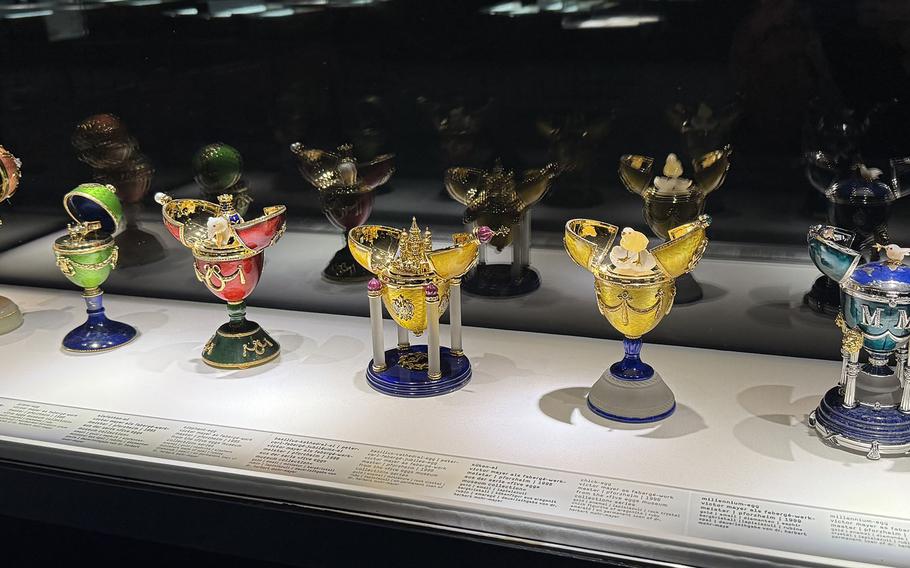
This case displays gold and enamel eggs adorned with gems at the Pforzheim Jewelry Museum in Pforzheim, Germany. The work was created in Pforzheim from 1995-1999. (Matt Wagner/Stars and Stripes)
Since moving to Germany two years ago, I’ve learned to curse out Pforzheim.
It’s no fault of the city, which is about halfway between Karlsruhe and Stuttgart in the state of Baden-Württemberg. The construction on the A8 autobahn just north of town makes trips to Stuttgart for work or the Lake Constance area to visit friends a major pain.
Because my view seemed unfair, I researched Pforzheim, which is nicknamed the “Golden City.” That led me to learning about its history as the jewelry and watchmaking capital of Germany, which is well-documented at the Pforzheim Jewelry Museum.
In German, it’s known as the Schmuckmuseum, “schmuck” being the word for jewelry in German. The Yiddish-turned-English meaning is apparently unrelated to the German word.
It’s the only publicly owned museum dedicated exclusively to jewelry and it features 2,000 exhibits from many places, including Pforzheim.
Some of the jewelry on display goes back five millennia. One of the oldest pieces is just stones strung along for a necklace.
The newer jewelry was more ornate with various gemstones, diamonds, gold, silver and enamel. Two necklaces and a brooch were even made with strands of human hair. That threw me for a loop, considering it has been used in the past couple of centuries.
I was fascinated by the ring collection, which was split up by eras and various empires. It started with ancient Egypt and moved on to recent times. Included were rings from India and China between the 12th and 19th centuries, as well as Jewish wedding rings from between the 8th and 17th centuries.
Another section that caught my eye was the Philipp Walter collection of pocket watches. The Pforzheim watch manufacturer amassed 212 of them made between 1550 and 1923. Seeing these watches had me imagining wearing a three-piece suit, complete with top hat and monocle, just to pull off the look like a Victorian-era gentleman.
As I was checking out the collection, a voice over the loudspeaker announced a free tour that runs at 3 p.m. on Sundays. I went to the central room hoping to gain more details about the history of jewelry and watchmaking in Pforzheim, as well as the items on display.
Unfortunately, the tour was in German, so I missed a lot of what the guide said. But I did catch an interesting story that began with Margrave Karl Friedrich von Baden giving his blessing to the jewelry and watchmaking trades in 1767. They quickly took over commerce in the city.
The guide highlighted various pieces, including a French Revolution-era ring from belonging to one of the uprising’s ringleaders — although I missed the name because I was too focused on the German side to recognize anything French.

Visitors listen to a tour guide during a mid-December 2024 visit to the Pforzheim Jewelry Museum in Pforzheim, Germany. The tour in German is offered to guests at 3 p.m. Sundays. (Matt Wagner/Stars and Stripes)
She also talked about how the museum is overlooked even by those in the industry. During the city’s jubilee celebrating jewelry and watchmaking in Pforzheim in 2017, only one of 100 folks considered a tour of the museum, according to the guide.
That’s a shame. It certainly helped change my opinion of what Pforzheim has to offer.
Pforzheim Jewelry Museum
Address: Jahnstrasse 42, 75173 Pforzheim
Hours: 10 a.m. to 5 p.m. Tuesday through Sunday and holiday. Closed Christmas Eve, Christmas Day and New Year’s Eve
Prices: 4.50 euros for regular entrance, 6 euros to visit the Technical Museum of Pforzheim’s Jewelry and Watchmaking Industries. Guided tours in English cost 90 euros for one hour and 25 euros for children.
Information: 07231 39 2126; Online: schmuckmuseum.de/en